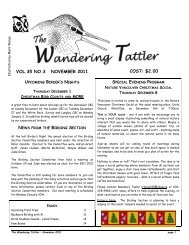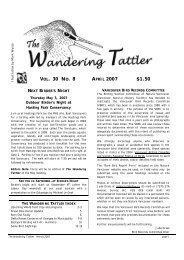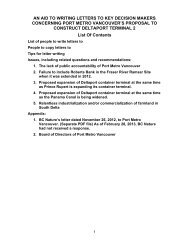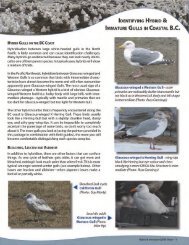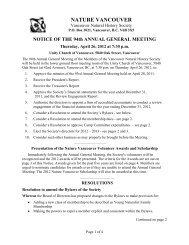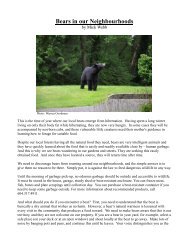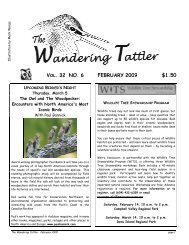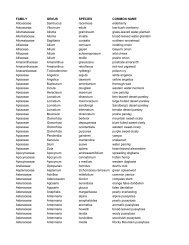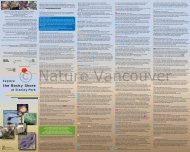Vancouver Naturalist_March 2012.pdf - Nature Vancouver
Vancouver Naturalist_March 2012.pdf - Nature Vancouver
Vancouver Naturalist_March 2012.pdf - Nature Vancouver
Create successful ePaper yourself
Turn your PDF publications into a flip-book with our unique Google optimized e-Paper software.
Conservation Matters<br />
continued from previous page<br />
hired consultant Gary Searing of Airport Wildlife Management<br />
International to develop and implement this program. Since then,<br />
40 raptors have been trapped and moved away from the airport:<br />
35 Red-tailed Hawks, 3 Rough-legged Hawks, and 2 Snowy Owls.<br />
Most of these were caught in a bal-chatri trap, which consists of a<br />
cage with a conspicuously visible (but protected) live rodent and<br />
a series of monofilament (invisible) nooses that snag the legs of<br />
the raptor as it attempts to take the bait. Gary found that he had to<br />
keep a close eye on the baited trap because Bald Eagles will arrive<br />
very quickly to grab the snagged raptor. White tags with prominent<br />
numbers are placed on the wings of captured birds – right wing of<br />
a female and left wing of a male. The raptors are then handed over<br />
to OWL (Orphaned Wildlife Rehabilitation Society in Delta) for<br />
a health check, banding, and deportation to the Chilliwack area,<br />
where they are released.<br />
Seventeen of the relocated Red-tails have returned to YVR. Of<br />
these, 14 are known to be residents of Sea Island or regular winter<br />
visitors. These older birds have learned to avoid aircraft, so are<br />
not re-trapped but allowed to stay – although they are closely<br />
watched. Three of the returning birds were transients, while 18 of<br />
the relocated Red-tails have not been seen again. In general, young<br />
hawks and the transients do pose a hazard and are (re)trapped.<br />
Northern Harriers and most owls (Barn, Short-eared) are wary of<br />
traps and none have been caught. Unfortunately, Barn Owls are<br />
frequent strike victims – one per month on average.<br />
Tour of the Airfield At the wildlife control field station, we<br />
were shown the bal-chatri trap and various other devices used<br />
to handle, tag, and care for the raptors during their short-term in<br />
captivity. Out on the airfield we viewed a Swedish Goshawk trap,<br />
designed to catch large raptors. This is a large cage with doors that<br />
close when a heavy bird lands on a central perch. Large raptors are<br />
attracted to the vicinity of this trap by flurries of starlings held in<br />
an adjacent wire-mesh enclosure (with food and roosting cavities<br />
supplied), and a live pigeon in placed in a separate compartment<br />
beneath the trap itself.<br />
Measures being taken make airfield habitat less attractive to large<br />
birds include covering (i.e., culverting) ditches to avoid attracting<br />
ducks and herons, and installing arrays of shiny streamers that<br />
flap in the wind also along ditches. Maintaining the best possible<br />
drainage of the grassy areas is also important because standing<br />
water will attract ducks.<br />
On the outer dyke we met a wildlife controller who demonstrated<br />
some of the arsenal of firecrackers – bangers, screamers and twisters<br />
– that are used to harass (frighten away) potentially hazardous<br />
flocks of birds. Live ammunition is used only as a last resort. Also<br />
effective is a powerful light beam that is used to “herd” flocks<br />
of Snow Geese away from the vicinity of airport runways. The<br />
wildlife control team includes two Border Collies; we met one,<br />
with his handler.<br />
At present, falconry is being tested as a means of wildlife control;<br />
last year there were two successful trials. Falcons have been used<br />
previously at YVR to evict unwanted birds, such as pigeons, from<br />
aircraft hangers. Now they may be used to disperse potentially<br />
hazardous birds, such as the hundreds of Dunlin that forage and<br />
loaf in the intertidal areas, but move onto the airfield and runways<br />
during high tides and during stormy weather. When a falcon is<br />
flown in a straight line from one handler to another, Dunlin flee the<br />
raptor’s flight path. (The falcon is trained not to pursue individual<br />
birds since a chase could end up in the path of an aircraft.) Further<br />
trials are planned.<br />
Other aspects of wildlife control mentioned only briefly during the<br />
course of the morning included: the new security fence, designed<br />
to keep out coyotes so it extends well below ground level; when<br />
a strike occurs, there is a requirement for runway closure until the<br />
remains of the bird or animal are found and removed; the problems<br />
of trying to manage the voles and mice that attract the raptors to<br />
the airfield; and control policies for geese and herons.<br />
It was a morning very well spent. We learned much about YVR’s<br />
wildlife management program and gained insight into the difficulties<br />
and heavy responsibilities faced by the wildlife technicians as they<br />
do their best to avoid unnecessary culling of birds while maintaining<br />
the safety of aircraft and the travelling public. Many thanks to<br />
Simon Robinson, Gary Searing, Dave Ball and the other wildlife<br />
technicians who spent the morning with us.<br />
<strong>Nature</strong> <strong>Vancouver</strong> members attending: Daniel Overmyer, Margaret<br />
Coutts, Bev Ramey, Jeremy McCall, Richard Swanston and June<br />
Ryder.<br />
If you see raptor with a large white wing tag, record the number on<br />
the wing tag if possible, the wing (right or left) that is tagged, time<br />
and location of the sighting, and send to gfd@airportwildlife.ca.<br />
<strong>Vancouver</strong> <strong>Naturalist</strong> <strong>March</strong> 2012 5



